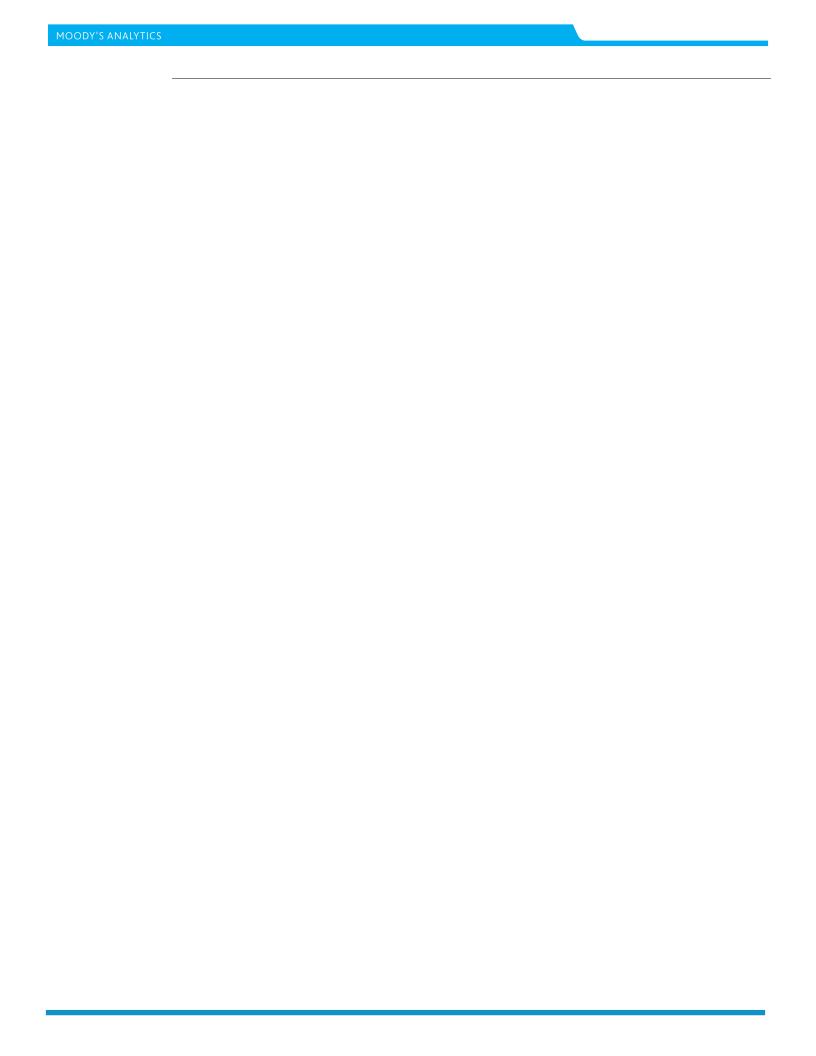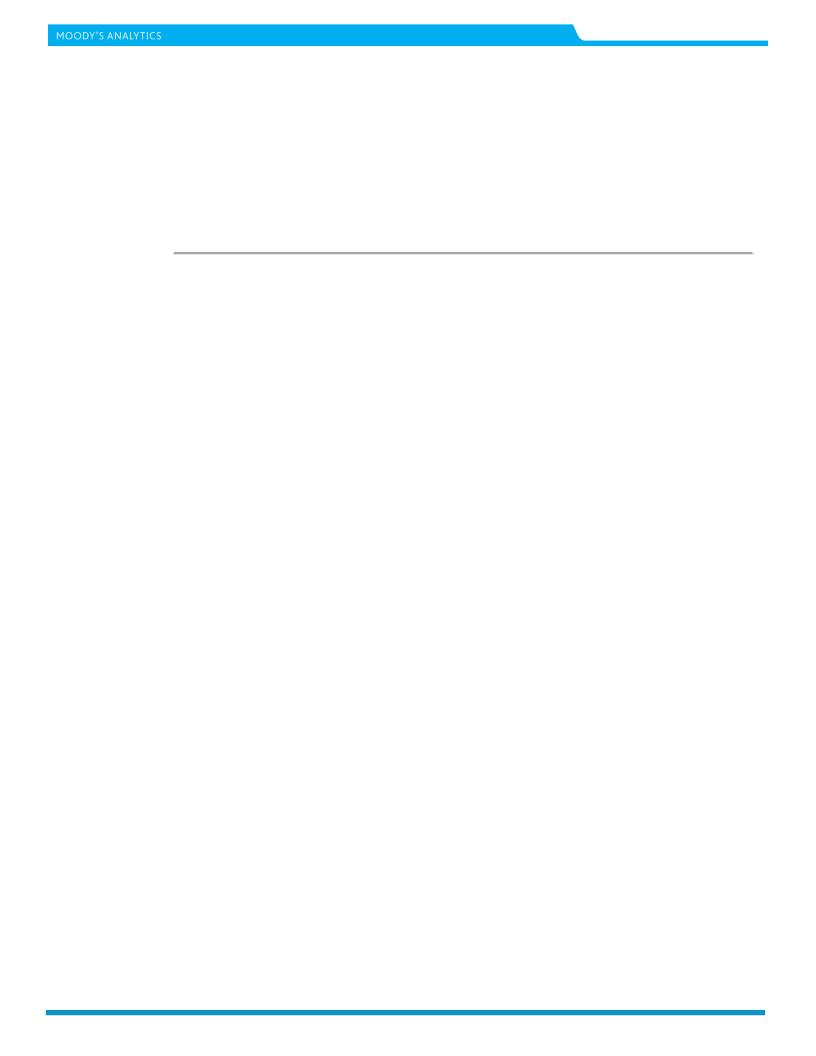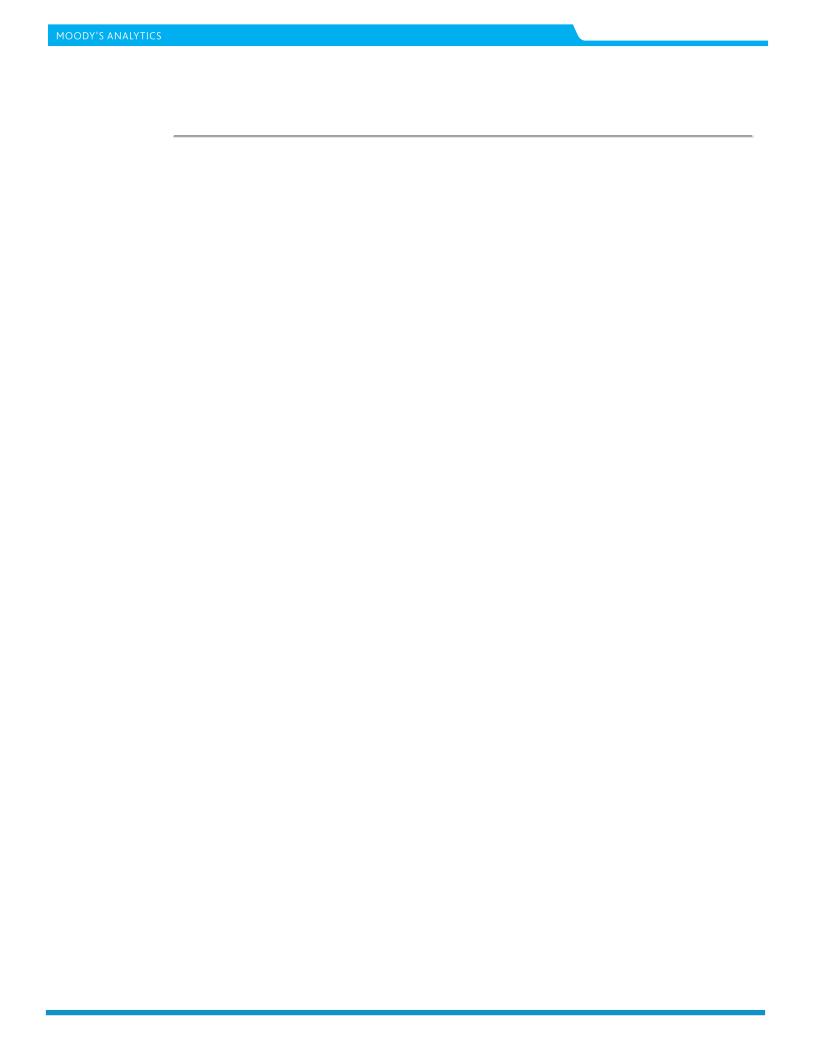
- •The Week Ahead
- •The Long View
- •Ratings Round-Up
- •Market Data
- •Moody’s Capital Markets Research recent publications
- •Weekly Market Outlook Contributors:
- •Credit Markets Review and Outlook
- •Only the Baa3 Spread Was Wider than Its Long-Term Median as of the End of June
- •Corporate Bond Yields and EDFs Provide the Basis for Market Implied Ratings
- •Bond Implied Ratings Offer a Somewhat Negative View of Baa3 Credits
- •EDF-Derived Market Implied Ratings Offered a More Positive View of Baa3 Credits
- •Despite Thinner Spread since End of 2018, Bond Implied Ratings of Baa3 Group Softens
- •The Week Ahead – U.S., Europe, Asia-Pacific
- •Perception versus reality
- •Looking ahead
- •The key data next week include June retail sales, industrial production, business inventories, consumer confidence and jobless claims.
- •EUROPE
- •Asia-Pacific
- •The Long View
- •Credit spreads
- •The recent high-yield bond spread of 421 bp is thinner than what is suggested by both the accompanying long-term Baa industrial company bond yield spread of 186 bp but is wider than what ordinarily accompanies the recent VIX of 12.9 points.
- •Defaults
- •US CORPORATE BOND ISSUANCE
- •US Economic Outlook
- •United Kingdom
- •Asia Pacific
- •china
- •Japan
- •Ratings Round-Up
- •Moody’s Capital Markets Research recent publications

vk.com/id446425943
The Long View
The Long View
CAPITAL MARKETS RESEARCH
Oil & gas figured in 19% and retailing entered into 12% of the high-yield downgrades of the second-quarter-to-date.
By John Lonski, Chief Economist, Moody’s Capital Markets Research Group
July 11, 2019
CREDIT SPREADS
As measured by Moody's long-term average corporate bond yield, the recent investment grade corporate bond yield spread of 119 basis points is just under its 122-point mean of the two previous economic recoveries. This spread may be no wider than 135 bp by year-end 2019.
The recent high-yield bond spread of 421 bp is thinner than what is suggested by both the accompanying long-term Baa industrial company bond yield spread of 186 bp but is wider than what ordinarily accompanies the recent VIX of 12.9 points.
DEFAULTS
June 2019’s U.S. high-yield default rate was 3.0%. The high-yield default rate may average 3.2% during 2019’s final quarter, according to Moody’s Investors Service.
US CORPORATE BOND ISSUANCE
Yearlong 2017’s US$-denominated bond issuance rose by 6.8% annually for IG, to $1.508 trillion and soared by 33.0% to $453 billion for high yield. Across broad rating categories, 2017’s newly rated bank loan programs from high-yield issuers sank by 26.2% to $72 billion for Baa, advanced by 50.6% to $319 billion for Ba, soared by 56.0% to $293 billion for programs graded single B, and increased by 28.1% to $25.5 billion for new loans rated Caa.
First-quarter 2018’s worldwide offerings of corporate bonds incurred year-over-year setbacks of 6.3% for IG and 18.6% for high-yield, wherein US$-denominated offerings posted sank by 14.4% for IG and 20.8% for high yield.
Second-quarter 2018’s worldwide offerings of corporate bonds eked out an annual increase of 2.8% for IG, but incurred an annual plunge of 20.4% for high-yield, wherein US$-denominated offerings rose by 1.6% for IG and plummeted by 28.1% for high yield.
Third-quarter 2018’s worldwide offerings of corporate bonds showed year-over-year setbacks of 6.0% for IG and 38.7 % for high-yield, wherein US$-denominated offerings plunged by 24.4% for IG and by 37.5% for high yield.
Fourth-quarter 2018’s worldwide offerings of corporate bonds incurred annual setbacks of 23.4% for IG and 75.5% for high-yield, wherein US$-denominated offerings plunged by 26.1% for IG and by 74.1% for high yield.
First-quarter 2019’s worldwide offerings of corporate bonds revealed annual setbacks of 0.5% for IG and 3.6% for high-yield, wherein US$-denominated offerings fell by 2.3% for IG and grew by 7.1% for high yield.
During yearlong 2017, worldwide corporate bond offerings increased by 4.1% annually (to $2.501 trillion) for IG and advanced by 41.5% for high yield (to $603 billion).
For 2018, worldwide corporate bond offerings sank by 7.2% annually (to $2.322 trillion) for IG and plummeted by 37.6% for high yield (to $376 billion). The projected annual percent increases for 2019’s worldwide corporate bond offerings are 4.6% for IG and 18.0% for high yield. When stated in U.S. dollars, issuers based outside the U.S. supplied 60% of the investment-grade and 61% of the high-yield bond offerings of 2019’s first quarter.
9 |
JULY 11, 2019 |
CAPITAL MARKETS RESEARCH / MARKET OUTLOOK / MOODYS.COM |

vk.com/id446425943 |
CAPITAL MARKETS RESEARCH |
|
The Long View
US ECONOMIC OUTLOOK
As inferred from the CME Group’s FedWatch Tool, the futures market recently assigned an implied probability of 100% to a cutting of the federal funds rate at the July 31, 2019 meeting of the Federal Open Market Committee. In view of the underutilization of the world’s productive resources, low inflation should help to rein in Treasury bond yields. As long as the global economy operates below trend, the 10-year Treasury yield may not remain above 3% for long. A fundamentally excessive climb by Treasury bond yields and a pronounced slowing by expenditures in dynamic emerging market countries are among the biggest threats to the adequacy of economic growth and credit spreads.
EUROPE
By Barbara Teixeira Araujo of Moody’s Analytics
July 11, 2019
UNITED KINGDOM
Thursday saw the release of the Bank of England’s twice-yearly Financial Stability Report. As expected, the focus was on what a no-deal Brexit would do to financial markets, and the bank concluded nothing new. The BoE again assured that city banks are well-prepared to withstand any shock related to the U.K. crashing out of the EU with no deal on October 31, and that all of the U.K.’s biggest banks would manage to continue trading without risk of collapse. Adding to the good news was the BoE’s claim that those banks could withstand a no-deal Brexit even if it were compounded by an international trade war, given the heightened trade tensions between the U.S. and China.
The central bank warned that a major threat remains, though, as European companies are at significant risk of losing access to their lenders overnight if the U.K. leaves with no deal on Halloween. The BoE stated that half of those EU companies using banks registered in Britain would be cut off from their bank services. That’s because, while the U.K. has passed legislation that would allow British firms banking with EU banks located in the country to keep on trading in the same way, the EU has not taken similar steps yet.
This would only add to the huge numbers of disruptions caused by a hasty exit. Although this is not our base case scenario—we expect that the U.K. will eventually leave with a deal, even if it does so under a Labour government— the chances of a no-deal exit have soared lately, as Boris Johnson remains the favourite candidate to replace Theresa May as prime minister. Johnson’s tough Brexit stance—he has repeatedly said that Brexit will happen on October 31, come what may—suggests that he would have no problem with a no-deal Brexit. And while we think that Parliament would try to stop him if push came to shove, the main risk here is that he decides to shut down Parliament, making it impossible for lawmakers to stop him. It’s worrying that in a televised debate this week, Johnson refused to rule out suspending Parliament. By contrast, his opponent Jeremy Hunt said he would not shut it down.
Although the rebound in the U.K.’s GDP in May was welcome following the dismal figures for April, looking past the volatility the main story from the release was that the underlying momentum in the economy remained weak in the middle of the second quarter. This is true mainly because growth in services output disappointed again; it held only steady over the month and failed to recover from the sorely unimpressive results for March and April. Services output accounts for around 80% of all that is produced in the U.K. economy and is a far better indicator of the economy’s direction, since it is less volatile and was less affected by the stockpiling before the March Brexit deadline.
A key downside detail was that growth in financial services output fell for the 15th consecutive month in May, as companies continued to relocate part of their operations to continental Europe, fearing what will happen to their ‘passporting rights’ when the U.K. finally leaves the EU. But output in most other service subsectors also disappointed, highlighting just how little momentum is in the U.K. economy right now, and that’s despite strongly rising wages and a still-solid labour market.
Worth noting is that significant upward revisions to March’s figures suggest that the numbers for the second quarter will be a better than previously expected. We now forecast that overall GDP held steady over the quarter—
10 |
JULY 11, 2019 |
CAPITAL MARKETS RESEARCH / MARKET OUTLOOK / MOODYS.COM |

vk.com/id446425943
The Long View
CAPITAL MARKETS RESEARCH
we had previously expected a fall—following a 0.5% q/q gain in the first stanza of the year. We project growth will remain subdued during the second half of 2019 as well, at an average of around 0.2% q/q.
ASIA PACIFIC
By Katrina Ell of Moody’s Analytics
July 11, 2019
CHINA
China has had a tough year. The enduring trade war with the U.S. has hurt manufacturing and exports and steepened the entrenched structural decline in broad economic conditions. Evidence is rising of the disruption to manufacturing production lines from the trade dispute, and forward indicators including new export orders suggest weakness through the second half of 2019. Inflation in China has been a background issue this past year. But the outbreak of African swine flu has made inflation a bigger concern in recent months, a situation that is unlikely to be resolved quickly.
Beijing’s quest to stabilize domestic demand has proven difficult. China's May activity data mostly surprised on the downside, against market consensus for an improvement from April's already disappointing print. In particular, fixed asset investment cooled in May for a second straight month, to 5.6% y/y year to date, its weakest reading since September, following the 6.1% gain in April. Industrial production also slowed, against expectations for it to at least hold steady; it came in at 5% y/y in May, the softest reading since 2002, after April's 5.4%. Some improvement is expected in the June numbers.
Stimulus this cycle has been measured and piecemeal, with the longer-term goal of achieving higher-quality growth. The government has avoided the large-scale stimulus of prior downturns, and this has resulted in a gradual improvement of some conditions, namely via infrastructure spending, tax cuts, and easing credit conditions in some sectors. Further stimulus is expected into 2020, not least because the unresolved trade war between the U.S. and China continues to hurt the manufacturing and export sectors. The monetary stimulus will continue focusing on smaller, private firms.
JAPAN
The Bank of Japan signaled in June that it is ready and willing to up the stimulus, if necessary. Governor Haruhiko Kuroda said that the bank could combine bigger asset purchases with interest rate cuts, if the downside risks to global growth materialized and further hurt Japan's already weakened economy. Whispers that the BoJ will need to up the ante have been growing for some time, given that the 2% inflation target is unlikely to be hit in the foreseeable future. But this is not a straightforward, win-win endeavour. Negative rates are distorting financial markets and profitability of financial institutions, particularly regional banks, which are already struggling with the side effects of an aging population.
Japan’s important export sector is struggling. Exports fell for a sixth straight month in May, with particular weakness in semiconductors and auto parts bound for China. Headline exports fell by 7.8% y/y in May, from April’s 2.4% decline. The slowdown in exports was likely exacerbated by the 10-day holiday in Japan for the enthronement of the new emperor. The Tankan survey shows that business conditions hit a three-year low in the June quarter. Business sentiment has been deteriorating since late 2017, coinciding with the trade war escalation. This is denting capital investment plans and hiring intentions.
The bright spot in Japan’s economy is the labour market. The job-to-applicant ratio was 1.63 in May, near its highest on record. There is a reasonable correlation between Japan’s vacancy rate and wages. As the vacancy rate rises, employers are forced to offer higher wages to secure the right candidate. The extent of tightening in Japan’s labour market is even more impressive when put in context of other developed markets. Less remarkable is the weak pass-through to higher wage growth.
Prime Minister Shinzo Abe recently confirmed that the October sales tax hike from 8% to 10% will go ahead as planned, despite growing speculation it would be delayed given the weakness at home and abroad. With this, we expect a temporary rise in spending in the third quarter, which will then collapse through the fourth quarter after the tax implementation, a situation that has occurred with Japan's other tax hikes.
11 |
JULY 11, 2019 |
CAPITAL MARKETS RESEARCH / MARKET OUTLOOK / MOODYS.COM |
